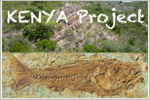Phylogenetically informative proteins from an Early Miocene rhinocerotid
In the past decade, ancient protein sequences have emerged as a valuable source of data for deep-time phylogenetic inference1–4. Still, even though ancient proteins have been reported from the Middle–Late Miocene5,6, the recovery of protein sequences providing subordinal-level phylogenetic insights does not exceed 3.7 million years ago (Pliocene)1. Here, we push this boundary back to 21–24 million years ago (Early Miocene) by retrieving enamel protein sequences of a rhinocerotid (Epiaceratherium sp.; CMNFV59632) from Canada’s High Arctic. We recover partial sequences of seven enamel proteins and more than 1,000 peptide–spectrum matches, spanning at least 251 amino acids. Endogeneity is in line with thermal age estimates and is supported by indicators of protein damage, including several spontaneous and irreversible chemical modifications accumulated during prolonged diagenesis. Bayesian tip-dating places the divergence time of CMNFV59632 in the Middle Eocene–Oligocene, coinciding with a phase of high rhinocerotid diversification7. This analysis identifies a later Oligocene divergence for Elasmotheriinae, weakening alternative models suggesting a deep basal split between Elasmotheriinae and Rhinocerotinae8,9. The findings are consistent with hypotheses on the origin of the enigmatic fauna of the Haughton Crater, which, in spite of considerable endemism, has similarity to distant Eurasian faunas10,11. Our findings demonstrate the potential of palaeoproteomics in obtaining phylogenetic information from a specimen that is approximately ten times older than any sample from which endogenous DNA has been obtained so far.
03.06.2025
Phylogenetic placement of deep-time (>1 million years ago (Ma)) fossils
has typically relied on morphological observations, because the
recovery of sufficiently extensive genetic evidence has not been proven
to be possible before the Pleistocene12. Weiter





